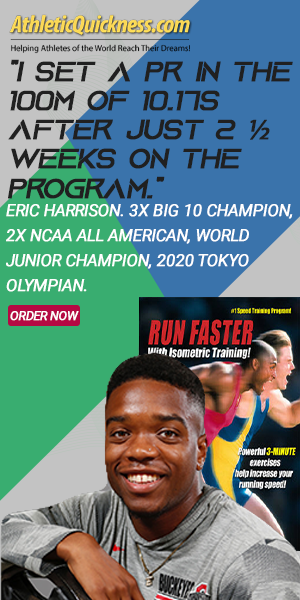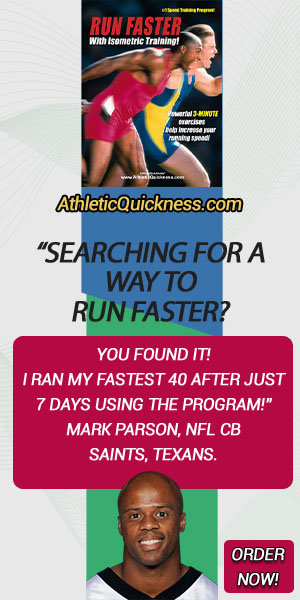Alright now the first thing I want to know from the people I train is what exercises and/or drills they are currently doing to help themselves run faster.
And the reason I want to know this information right from the beginning is because if a person is already doing some of the things that I typically recommend to help them get faster, then it will give me some idea of just how much I can really help and it will make our time spent together more profitable so that I don’t find myself discussing things they are already familiar with.
So, let’s start there with you…I want you to take a minute or two right now and jot down on a sheet of paper the top 5 or 10 exercises and/or drills you are currently doing or have done in the recent past to help yourself get faster. Don’t read on any further until you do this now!

Okay, take a look at the list seen above in Figure 1. These are the most popular speed training exercises I hear about when I ask people to tell me what they are doing to help themselves get faster and since they really are so popular, I am very confident that a lot of the ones seen on my list match the ones on yours.
There Are Always More Exercises to Do
Now, before I go any further, I do want to acknowledge that there will always be other exercises and/or drills one can add to this list and you may even have a few special ones of your own to include as well so, I intend to address the issue of there being additional exercises to consider later in this training series.
But for now, I want to keep our focus specifically on the exercises shown above in Figure 1 because for the most part, what you’re looking at is considered by many in the speed training world to be the most complete and most important group of exercises one can choose from when looking for ways to get faster.
Can We Still Help You Get Faster If You Are Already Doing These Popular Exercises?
So, it is at this early stage in our meeting, where I first learn about the exercises and/or drills someone is doing to try and get faster, that I can instantly tell whether or not I can help them, as well as the amount of help I can provide if I even can.
And so as far as you are concerned, if most of the exercises on your list appear above in Figure 1, then not only am happy to say that I can help you get faster, but I am also happy to say that I can help you get faster to the highest level possible.
And the reason I can say this with confidence is because the list of exercises seen above in Figure 1, the list of exercises everyone seems to be working from these days, is not as complete as you, or they, may have been led to believe.
In fact, I am willing to go so far as to say that this list is extremely incomplete and extremely narrow in its running speed focus and if all you ever do are the exercises from it or some close variation to them, then you will never even come close to reaching your true running speed potential.
Three Things You Must Know About This List of Exercises
So, if getting as fast as you can and performing at your highest level possible is really important to you, then you will need to understand at least three things about this list of exercises seen in Figure 1.
1) The first thing is you need to know what muscles are routinely being targeted by these exercises
2) the second thing is you need to what role these targeted muscles play in regards to helping you run faster and 3) the third, and perhaps the most important thing is you need to know whether or not the role these targeted muscles are playing is enough to meet ALL OF THE DEMANDS required for you to run faster.
Because if you fail to get clarification on any one or more of these three items then I’ve got news for you…you really aren’t training to run faster, you’re simply exercising for the sake of exercising and as a result you’re going to hit a plateau with your speed way too soon and get stuck there indefinitely. And I suspect many of you are there right now desperately looking for some help!
Therefore, understanding these three things about this list is the first step in your journey to running faster and it’s my job to help you understand them. So, let’s begin by looking at item #1 on this list, which again is, what muscles are routinely being targeted by these exercises?
Item #1: What muscles are routinely being targeted by this list of exercises?
As a quick overview before we start, I want to show you how this list is laid out. The column of exercises on the left shown below in Figure 2 lists all the heavy lifting exercises such as the squat and deadlift. The middle column shown below in Figure 2 lists all of the resisted running type of exercises such as running with a parachute or weight sled. And the column on the right shown below in Figure 2 lists all of the jumping type of exercises or bodyweight exercises people do such as broad jumps and depth jumps.

Focus on muscles in the hips, thighs and legs
Okay, now, as we take a closer look at these exercises, I want to keep our focus on the muscles involved in and around the lower extremities, or, the hips, thighs and lower leg, since that will be easier and more relevant to our discussion as well as those are usually the areas athletes are looking to improve their strength in anyway.
Starting with the Exercises in The Left-Hand Column

Figure 3
Referring to Figure 3 above and starting with the squats, those being your basic free weight squat with the bar placed across the back of your shoulders as well as the hack squat where you are on a sled machine we know they are both going to exercise mainly the glutes/hams on the backside of your hip and thigh, which I like to call the hip extensors or thigh extensor muscles, and they also target the quadriceps in the front of your thigh also known as the knee, or, leg extensors.
Leg presses are going to target the same muscles, those being the glutes/hams on the back of the hip and thigh and the quads in the front of the thigh. Deadlifts target the glutes/hams in the back and the quads in front.
Romanian Deadlifts, or, straight leg deadlifts target mainly the glutes/hams in the back of the hip and thigh. The Olympic lifts such as the power clean and clean/pulls are going to target the glutes/hams in the back of the hip and thigh, the quads in the front of the thigh and calf muscles in the back of your lower leg.
Calf raises are pretty self-explanatory in targeting the calf muscles in the back of your lower leg. Leg extensions, which are performed on a machine, are going to target the quads or quadriceps in the front of the thigh. And the last one in this group, the hamstring curls. They are also performed on a machine they target the hams or hamstring muscles in the back of the hip and thigh.
Moving on to the Middle Column of Exercises

Figure 4. Middle Column of Exercises.
Moving on to the middle column above in Figure 4 with all of the running type of exercises, the only leg that gets any significant resistance or exercise is the one of the ground supporting the entire weight of the body which is the right leg seen in our athlete below in Figure 5 and in doing so, the glutes, the hamstrings, the quads and calves are targeted.

Figure 5. Leg on the ground gets the most exercise.
So, it doesn’t matter if you are dragging a parachute, weight sled, or tire, or even being restrained by a resistance band held by another person, only the leg on the ground is getting the real workout. And it doesn’t matter if you are running steps, running up hill or running downhill, again, only the leg on the ground is getting the most exercise. And the same for interval running or doing cone, shuttle or ladder drills. Again, only the leg touching the ground is getting the majority of the exercise and in process with all of these running type of exercises, only the glutes/hams, quads and calves are being targeted.
Moving on to the Right-Hand Column of Exercises

Figure 6. Right-Hand Column of Exercises.
And finally, in the last column on the right shown above in Figure 6, with all of the jumping exercises such as the standing broad jump, jumping rope, tuck jumps, approach jumps, box jumps, side to side jumps and depth jumps it’s the leg or legs pushing off the ground or even landing on the ground are going to receive the most resistance and just like the muscles targeted for all of the running exercises, the same muscles are targeted here which again are the glutes/hams, quads and calf muscles.
After that we have the lunge and I think there could be upwards of 30 different variations of it by now and all of them will target mainly the glutes/hams and quads. Below that is the glute/ham raise exercise which obviously targets the glutes/hams. And finally, the wall squat is another bodyweight exercise and will target the glutes/hams and quads just like the ones performed with added weight.
What muscles are routinely being targeted by this list of exercises?
So, after going through this list did you notice any pattern with respects to which muscles are getting the most attention? Because you should have! This list of exercises targets primarily the glutes/hams, quads and calf muscles and that is the answer to our first item regarding the list and it is very important you understand this going forward.
I Want to Hear from You!
Now, before we go on and address the second item pertaining to this list, which is that what role do these muscles play in your running speed, I want to hear from you regarding what we just covered:
First, I want to know whether or not you agree with me that the exercises shown in this list are among the most popular to choose from when it comes to helping you improve your running speed.
Second, I want to know how many of the exercises on your list match the ones on mine. If you initially wrote down say 10 exercises, did you see 5 of you exercises on our list? 7 out of 10? 10 out of 10? Let us know how many exercises you had on your list and then how many of those match the ones on mine.
And third, I want to know what percent of your current speed training routine do you think revolves around exercising just your glutes/hams, quads and calves? Would you say, 50%? 75%? 100%?
Please take the time to comment below so that we all can benefit from the discussion. Thank you!






